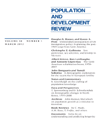
POPULATION AND DEVELOPMENT REVIEW
Scope & Guideline
Illuminating the Complexities of Population and Progress.
Introduction
Aims and Scopes
- Demographic Analysis and Trends:
The journal covers various demographic phenomena, including fertility rates, migration patterns, and mortality trends, offering insights into how these factors influence societal structures and policies. - Social and Economic Implications of Population Changes:
Research published in the journal often discusses the socio-economic consequences of demographic transitions, such as shifts in family structures, economic inequality, and public health outcomes. - Interdisciplinary Approaches to Population Studies:
The journal encourages interdisciplinary research that integrates perspectives from sociology, economics, public health, and environmental studies to address complex demographic issues. - Policy-Relevant Research:
A significant focus is placed on providing empirical evidence that can inform public policy and development strategies, particularly in the context of global challenges such as climate change and migration. - Cultural and Geographic Diversity:
The journal highlights the importance of cultural and geographic contexts in shaping demographic trends, with a particular emphasis on low- and middle-income countries.
Trending and Emerging
- Impact of Global Crises on Demographics:
There is a significant trend toward analyzing how global crises, such as the COVID-19 pandemic, affect demographic trends, including fertility, migration, and mortality, reflecting real-time issues faced by societies. - Intersection of Gender and Demographics:
Emerging research emphasizes the intersectionality of gender with demographic factors, exploring how gender roles and expectations shape fertility choices, migration patterns, and family dynamics. - Migration and Refugee Studies:
Increased focus on migration policies and the experiences of refugees highlights the need to understand demographic changes in the context of global mobility and humanitarian crises. - Environmental Factors in Demographic Change:
Research increasingly examines the relationship between environmental changes, such as climate change, and demographic shifts, particularly how these factors influence migration and population health. - Data Innovation in Demography:
The use of novel data sources, including digital trace data and big data analytics, is becoming more prevalent, offering fresh insights into demographic trends and enhancing predictive modeling capabilities.
Declining or Waning
- Traditional Fertility Studies:
While fertility remains a core topic, there is a noticeable shift away from traditional studies focused solely on quantitative fertility rates, with more emphasis now placed on qualitative aspects and broader social implications. - Static Migration Theories:
Older migration models that do not account for contemporary complexities or the fluidity of migration patterns are becoming less relevant, as newer frameworks that consider dynamic socio-political factors gain traction. - Overpopulation Narratives:
The narrative surrounding overpopulation as a singular issue has waned, with a growing recognition of the need for nuanced discussions that incorporate sustainability and resource management rather than solely focusing on population size. - Homogeneous Policy Recommendations:
There is a move away from one-size-fits-all policy recommendations, as more research emphasizes the need for context-specific solutions that consider local cultures, economies, and environments. - Historical Demographic Models:
Research that solely relies on historical demographic models without accounting for contemporary variables and global interdependencies is seeing decreased publication frequency.
Similar Journals
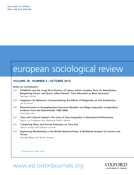
EUROPEAN SOCIOLOGICAL REVIEW
Elevating sociological research to new heights.European Sociological Review, published by Oxford University Press, stands as a leading journal in the fields of sociology and political science. With an impressive h-index and a 2023 ranking in the top 10th percentile (Q1) of Scopus, it represents a key platform for scholars and practitioners seeking to advance sociological discourse. Since its inception in 1985 and continuing through to 2024, this journal has provided a wide array of high-quality articles that explore various dimensions of sociological theory, research, and application, fostering a deeper understanding of social dynamics. Although not open access, the journal's rigorous peer-review process ensures that only the most impactful research is disseminated, making it an essential resource for academia, policy-making, and social research. By focusing on contemporary sociological challenges and contributing to significant debates, the European Sociological Review is invaluable for researchers, professionals, and students committed to the empirical understanding of societal trends.
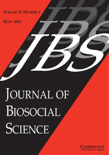
JOURNAL OF BIOSOCIAL SCIENCE
Pioneering Research in the Biosocial Dimensions of HealthJOURNAL OF BIOSOCIAL SCIENCE, published by Cambridge University Press, is a pivotal interdisciplinary journal dedicated to advancing our understanding of the complex interplay between biological and social factors in human health and society. With an ISSN of 0021-9320 and an E-ISSN of 1469-7599, this journal has been a cornerstone of scholarly communication since its inception in 1969, paving the way for innovative research until 2024 and beyond. The journal is ranked in the Q3 quartile in Public Health, Environmental and Occupational Health and Q2 in Social Sciences (miscellaneous), reflecting its significant impact in these fields. Its Scopus ranking further emphasizes its relevance, sitting at #79 out of 275 in General Social Sciences and #334 out of 665 in Public Health. Researchers, professionals, and students are encouraged to explore the journal's rich repository of articles that delve into critical biosocial issues, fostering a deeper understanding of how social structures influence health and well-being. Although not open access, the journal remains an essential resource for those committed to addressing contemporary health challenges through a biosocial lens.
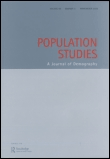
POPULATION STUDIES-A JOURNAL OF DEMOGRAPHY
Exploring the Dynamics of Demography and HistoryPopulation Studies: A Journal of Demography is an esteemed scholarly publication dedicated to advancing the understanding of demographic trends and their historical contexts. Published by Routledge Journals, Taylor & Francis Ltd, this journal has a notable impact in its field, recognized as a Q1 category journal in both Demography and History as of 2023. Its Scopus rankings highlight its significance, featuring a remarkable 12th place rank in Arts and Humanities—History and 19th place in Social Sciences—Demography, both underscoring its influential role in academic research. Established in 1947, the journal has consistently contributed to the discourse in population studies, offering a platform for innovative research and critical analysis. While it does not provide open access options, it remains a vital resource for researchers, professionals, and students who seek to explore the complex relationships between population dynamics and historical narratives. Its comprehensive coverage from 1947 to 2024 ensures a rich repository of knowledge, making it essential for anyone involved in demographic research.

Canadian Studies in Population
Shaping Insights into Population DynamicsCanadian Studies in Population, published by Springer, is a prestigious journal dedicated to advancing the field of demography and the history of population studies within Canada and beyond. With an ISSN of 0380-1489 and an E-ISSN of 1927-629X, this journal has proudly contributed to scholarly discourse since its inception in 1975, and continues to make significant impacts through its rigorous research articles and comprehensive reviews. Recognized for its high academic standards, it boasts a Q2 ranking in Demography and a Q1 ranking in History in 2023, reflecting the journal's critical role in shaping contemporary understanding of demographic trends and historical population developments. With a Scopus rank of #51/139 in Demography and #83/1760 in History, it appeals to a diverse audience including researchers, professionals, and students eager to explore population dynamics, historical context, and societal implications of demographic shifts. While the journal maintains traditional subscription access options, its rigorous peer-reviewed content ensures that it remains a cornerstone for scholars seeking credible and influential insights in their respective fields.

JOURNAL OF POPULATION ECONOMICS
Transforming Demographic Data into Economic InsightsThe JOURNAL OF POPULATION ECONOMICS, published by SPRINGER, stands as a leading peer-reviewed journal in the fields of demography and economics. Established in 1988, this esteemed journal offers a platform for high-quality research that probes the intricate relationships between population dynamics and economic phenomena. With its impressive Q1 quartile ranking in both Demography and Economics and Econometrics for 2023, the journal is recognized as a vital resource for scholars and practitioners alike, reflecting its rigorous standards and impact in the academic community. Its Scopus rankings position it within the top tiers of social sciences, making it an essential read for those engaged in demographic and economic research. Although the journal does not currently adopt an open access model, its esteemed reputation and continuous publication until 2024 ensure relevant and up-to-date findings contribute meaningfully to scholarly discourse. At its core, the JOURNAL OF POPULATION ECONOMICS aims to bridge theoretical insights and empirical findings, fostering an understanding of how population changes influence economic outcomes and vice versa.

Espaces-Populations-Societes
Bridging the Gap Between Population Studies and Spatial PlanningEspaces-Populations-Sociétés is a distinguished journal published by UNIV LILLE I SCI & TECH, focusing on the fields of demography and geography. Established in 1983, this open-access journal has committed itself to providing a platform for innovative research and discussions around population dynamics and spatial organization, with accessibility to its content available since 2004. Based in France, at the UFR Géographie & Aménagement, the journal plays a crucial role in advancing understanding of demographic trends and planning developments. With current Scopus rankings highlighting its position in the 25th and 14th percentiles for Demography and Geography, Planning and Development respectively, it maintains a reputable standing within academic circles, establishing its importance in contemporary research landscapes. Researchers, professionals, and students alike will find valuable insights in its comprehensive overview of sociocultural and environmental interactions, as well as place-based issues at the heart of societal development.

POPULATION AND ENVIRONMENT
Fostering Knowledge at the Intersection of Society and NaturePopulation and Environment is a renowned journal published by Springer, focusing on the critical intersection between demographic processes and environmental changes. Established in 1980, the journal has become a leading platform for interdisciplinary research, with its impressive impact reflected in its 2023 rankings, placing it in the Q1 quartile for both Demography and Environmental Science (miscellaneous) categories. With Scopus Ranks highlighting its prominent position (#11 out of 139 in Social Sciences – Demography, and #46 out of 219 in Environmental Science), Population and Environment fosters a rich dialogue among researchers, professionals, and students dedicated to understanding how population dynamics influence environmental conditions and vice versa. Operating without an open access option, the journal ensures high standards for scholarly contributions and remains committed to bridging knowledge gaps in the realms of population studies and environmental science. The journal's rigorous peer-review process and comprehensive archive from 1980 to 2024 solidify its reputation as an invaluable resource for advancing research and informing policy in these critical fields.

GENUS
Elevating Understanding of Demographic Trends and PoliciesGENUS is a prestigious open-access journal published by SpringerNature, dedicated to advancing research in the field of demography. With an E-ISSN of 2035-5556, it has been operating as an open-access platform since 2016, ensuring that valuable demographic knowledge is accessible to a global audience. Located in Switzerland, this journal contributes significantly to the scholarly community, achieving a remarkable Q1 ranking in the 2023 Scopus category for Social Sciences focusing on Demography, where it stands at an impressive Rank #12 out of 139, placing it in the 91st percentile. With a history that spans several decades, starting from 1970 and including comprehensive coverage from 2007 to 2024, GENUS provides a vital forum for researchers, professionals, and students seeking to engage deeply with current demographic studies. This journal not only publishes cutting-edge research but also facilitates fruitful discussions on key demographic trends and policies, making it an essential resource for anyone interested in the social sciences.
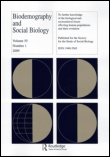
Biodemography and Social Biology
Pioneering Research at the Intersection of Biology and AnthropologyBiodemography and Social Biology is a distinguished academic journal published by Routledge Journals, Taylor & Francis Ltd, focusing on the intersections of demographic and biological sciences. With its ISSN 1948-5565 and E-ISSN 1948-5573, this journal contributes significantly to the fields of anthropology, demography, and social biology, making it an essential resource for researchers and professionals alike. The journal has consistently achieved high rankings, notably placing in Q2 in both anthropology and demography, underlining its impact in these critical areas of study. Although it does not provide Open Access options, the journal's rigorous peer-review process ensures the highest quality of academic discourse and research dissemination. Covering a wide scope of topics related to human population dynamics, health, and behavior, Biodemography and Social Biology serves as a vital platform for advancing knowledge and understanding of the biological and social factors influencing human societies since its inception in 1990. Researchers, students, and professionals are invited to contribute their findings and insights, enriching the academic conversation that this journal fosters.

Papeles de Poblacion
Unveiling the complexities of demographic change.Papeles de Población, published by the Universidad Autónoma del Estado de México, is a prominent open-access journal that has been advancing the field of demography since its inception in 1997. With an ISSN of 1405-7425, this journal aims to foster a deeper understanding of population studies through research articles, reviews, and critical analyses that address the complex dynamics of demographic changes, social structures, and their implications. While currently ranked in the fourth quartile of its category in 2023, it serves as a significant channel for researchers, professionals, and students to disseminate and access cutting-edge findings. Open access since 2004, it provides a platform for broader readership and knowledge sharing, thus contributing to the global discourse on population issues. Based in Mexico, the journal is committed to embracing diverse perspectives, emphasizing the importance of regional studies within a global context.